Catholic believers in the Philippines observed Good Friday this year with traditional self-flagellation rituals known as penitensya (“penitence”), marching in bloody processions to acknowledge their sins and be forgiven.
The Philippines hosts a variety of such processions featuring violence, despite the Vatican openly discouraging them, and up to 2019 hosted live crucifixions of participants. More commonly, Filipino believers organize Passion plays and, in Manila, the Black Nazarene procession typically attracts millions of people. This year, police called off the procession minutes after it began, claiming the crowd became immediately “unruly.”
The Philippine outlet ABS-CBN reported on a flagellation procession in Malolos, Bulacan, on Friday in which participants “whipped their backs in the belief their sins will be forgiven and divine favors will be granted.”
"Kristos" use leather straps or ropes with thorny wires to hit themselves at the back, carry a cross through different churches. Some would go further and get crucified on a cross on Good Friday. They consider it a spritual act to seek forgiveness. | @ABSCBNNews @DZMMTeleRadyo pic.twitter.com/0jhy5Ql17M
— Nico Bagsic (@nicobagsic) April 15, 2022
LOOK: Flagellants or "kristos" in Malolos, Bulacan walk their way from church to church this Good Friday for the traditional "penitensya" (repentance) during Holy Week. | @ABSCBNNews @DZMMTeleRadyo pic.twitter.com/f3VEIItQ0T
— Nico Bagsic (@nicobagsic) April 15, 2022
“It’s punishing but if you have a wish, you will endure the pain,” Roy Balatbat, a participant in Bulacan, told the Agence France-Presse (AFP). “I have been doing this for 30 years since I was a young man. My devotion is that I will only stop when I can’t do it anymore.”
AFP explained that those who flagellate have others open wounds on their backs initially, so as to maximize the pain.
“I inflict the wound to the penitents, if there’s not much blood coming out, they’ll ask for another one so their sins would be forgiven,” another participant, Reynaldo Tolentino, explained.
In Navotas, part of the Metro Manila region, dozens of men engaged in the floggings, leaving their own backs raw.
Warning – Graphic Images:
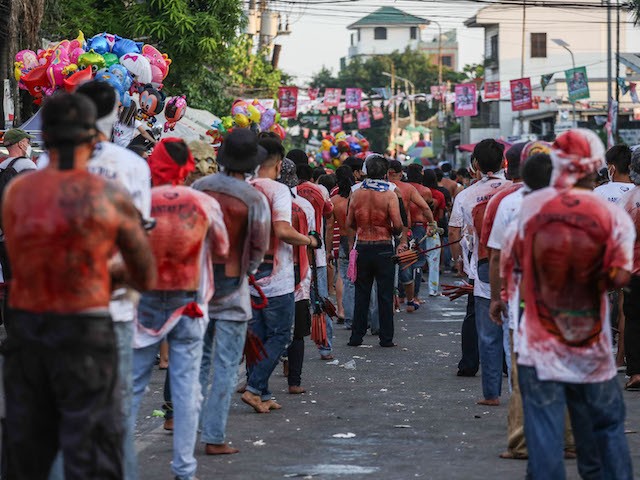
Catholic devotees flagellate themselves to mark the holy week of Easter in Navotas, suburban Manila on April 15, 2022. (JAM STA ROSA/AFP via Getty Images)
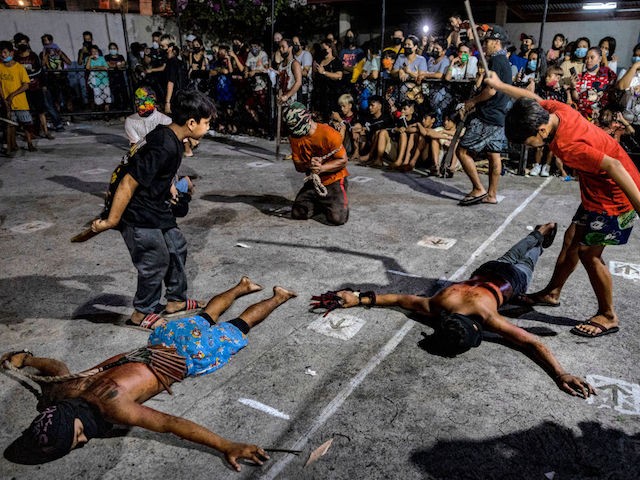
Flagellants with bloodied backs lie on the ground as they perform Good Friday Lenten Rites on April 15, 2022, in Navotas, Metro Manila, Philippines. (Ezra Acayan/Getty Images)

Flagellants with bloodied backs flog themselves as they perform Good Friday Lenten Rites on April 15, 2022 in Navotas, Metro Manila, Philippines. (Ezra Acayan/Getty Images)
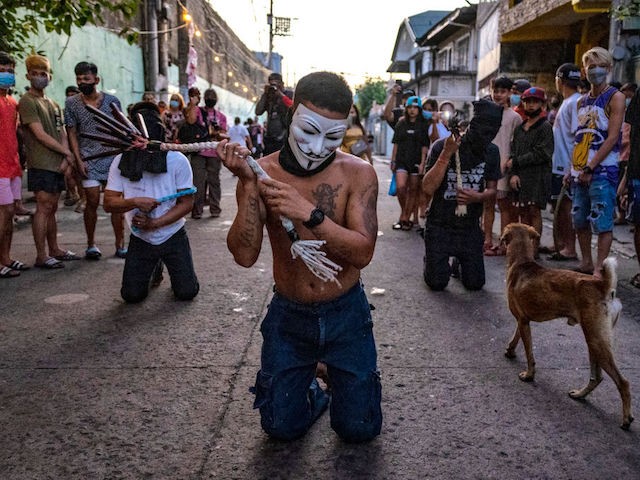
Flagellants with bloodied backs flog themselves as they perform Good Friday Lenten Rites on April 15, 2022 in Navotas, Metro Manila, Philippines. (Ezra Acayan/Getty Images)
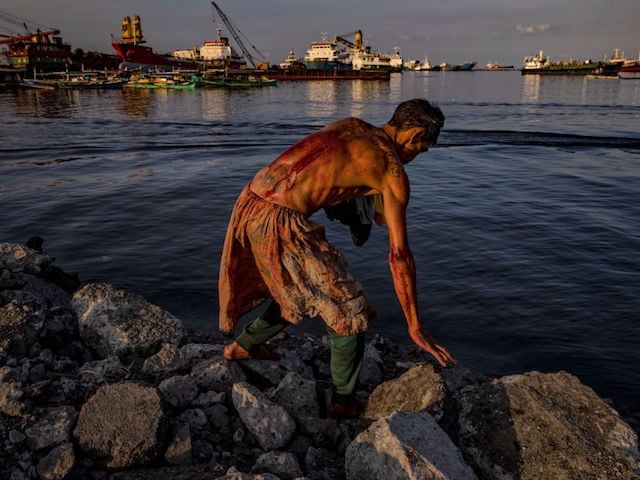
A flagellant with a bloodied back cleans his wounds in the polluted waters of Manila bay after performing Good Friday Lenten Rites on April 15, 2022, in Navotas, Metro Manila, Philippines.(Ezra Acayan/Getty Images)
San Pedro Cutud – a small town in Pampanga, about two hours from Manila – typically hosts live crucifixions. Many of those participating have been doing so for years – in some cases, decades – though the number had begun to shrink by 2019, the last year the government allowed the event to take place. Following the eruption of the Chinese coronavirus pandemic, authorities canceled the crucifixions, as they tended to encourage tourist travel that officials argued could spread the disease.
Ruben Enaje, a carpenter, holds the record for being crucified the most times, having participated in the ritual on 33 occasions. Enaje told the Manila Standard that he was expecting to retire after one more crucifixion.
“I was ready to be crucified on the cross this Good Friday when he was told to cancel again,” he said. “I am looking forward next year to be nailed on the cross for the last time when I will be 61 years old.”
Enaje told the newspaper that he began participating in the ritual in 1986 after falling three floors and landing uninjured. He attributes the “miracle” to shouting “Dios ko!” (“My God!”) as he fell.
“I owe my life to Jesus that’s why every Good Friday I have to undergo the crucifixion ritual,” he explained.
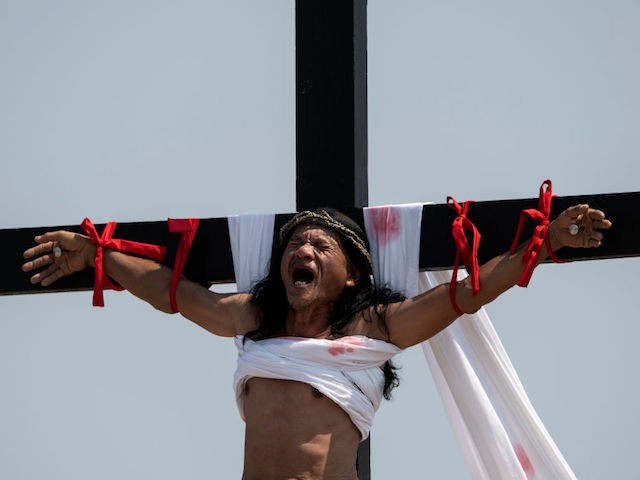
Philippine Christian devotee Ruben Enaje, 58, reacts as he is nailed to a cross during a reenactment of the Crucifixion of Christ during Good Friday ahead of Easter in the village of Cutud near San Fernando on April 19, 2019. (NOEL CELIS/AFP/Getty Images)
In Manila, police had finally allowed the procession of the Black Nazarene, an annual Good Friday tradition, to occur despite the pandemic, but barely allowed the crowd to participate. Authorities deployed nearly 1,300 police officers in anticipation of a large crowd, who reportedly failed to contain the crowd. The procession typically begins at midnight.
“However, upon reaching the Villalobos and Carlos Palanca Street, Quiapo, Manila, an uncontrolled crowd blocked the road/path of the truck that carries the image of the black Nazarene, forcing the ground commander and the church leaders to implement the contingency plan that was agreed in the last coordinating meeting,” Manila Police Department Director Leo Francisco said in a statement on Friday, “which is to promptly head back the image to the Church to ensure that chances for the transmission of the [Chinese coronavirus] among the devotees will be none.”
The Philippine Star estimated that 70,000 people had gathered for the procession.
The Philippines has a large Catholic majority, about 86 percent, and is over 90 percent Christian generally. The government has been significantly more antagonistic to the Church under current President Rodrigo Duterte, however, who has repeatedly encouraged violence against priests and called Pope Francis a “son of a whole.” Duterte claims that a priest molested him during a Confession when he was “14 or 15,” naming Father Paul Falvey, S.J., who left the Philippines and went on to be accused of molesting children in the United States.
Duterte’s government has also implemented severe mobility restrictions following the onset of the Chinese coronavirus pandemic, particularly targeting the faithful.
“No more religious gatherings. Full stop!” Duterte spokesman Harry Roque scolded last year, a warning that went largely unheeded.
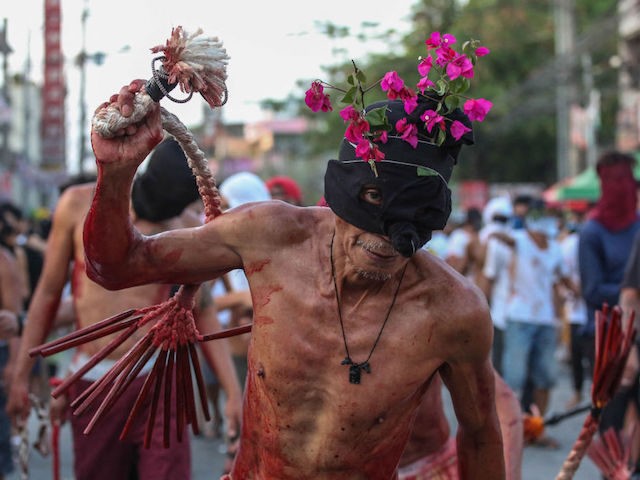
COMMENTS
Please let us know if you're having issues with commenting.